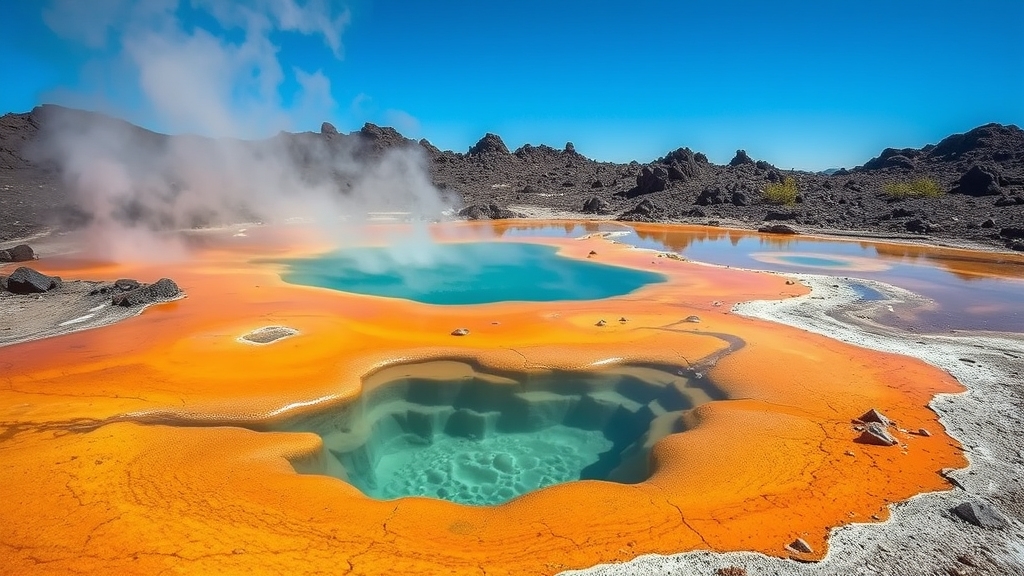Microorganisms in extreme environments show remarkable resilience and adaptability, helping maintain ecosystem balance even in places like deep-sea vents and acidic springs. They survive harsh conditions through specialized enzymes, unique metabolic pathways, and protective structures. These microbes support nutrient cycles and energy production without sunlight, proving life’s incredible diversity. Their survival strategies reveal how ecosystems can thrive in the most unlikely spots. Keep exploring to uncover the fascinating ways life persists against all odds.
Key Takeaways
- Microorganisms adapt through specialized enzymes and structures to survive in extreme conditions like high temperatures, acidity, and radiation.
- Extremophile microbes contribute to nutrient cycling and energy production in harsh environments without sunlight.
- Microbial diversity in extreme habitats includes thermophiles, acidophiles, and halophiles, supporting ecosystem resilience.
- These microbes demonstrate life’s ability to thrive beyond conventional environments, showcasing resilience and evolutionary success.
- Studying extremophiles offers insights into potential extraterrestrial life and the interconnectedness of ecosystems in extreme habitats.

Have you ever wondered how different components of an ecosystem work together to sustain life? It’s fascinating to realize that even in the harshest environments, life finds a way to thrive. At the heart of these ecosystems are microorganisms that have developed remarkable adaptations, allowing them to survive and function where most life forms would perish. These microbial adaptations are essential for maintaining the balance of ecosystems in extreme environments, such as deep-sea vents, acidic hot springs, or arid deserts. By evolving specific features—like specialized enzymes, protective cell structures, or unique metabolic pathways—these microbes can withstand extreme temperatures, high acidity, or intense radiation. Their ability to adapt is a testament to life’s resilience and diversity, especially among extremophiles, the organisms that flourish in such conditions.
Extremophile diversity is astonishing. You might think that life in extreme environments would be limited to just a few hardy species, but in reality, there’s a vast array of microbial life, each with unique characteristics tailored to their specific habitats. For example, thermophiles thrive in scorching hot springs where temperatures soar beyond boiling point, while acidophiles flourish in acidic lakes with pH levels that would dissolve most other life forms. Then there are halophiles, which thrive in hypersaline environments like salt flats, adapting to osmotic pressures that would crush most organisms. These microbes often form complex communities, interacting and exchanging nutrients in ways that sustain their survival and, in some cases, influence the entire ecosystem. Understanding these microbial adaptations is crucial for appreciating their role in supporting life in extreme conditions.
What’s truly remarkable is how microbial adaptations contribute not only to their survival but also to the broader ecosystem functions. They participate in processes like nutrient cycling, organic matter decomposition, and even energy production in environments devoid of sunlight. Some extremophiles can produce energy through chemosynthesis, harnessing chemical reactions instead of relying on photosynthesis. This ability creates a foundation for other life forms, including larger organisms, to exist in otherwise inhospitable environments. Their diversity and resilience expand our understanding of what it means to be alive, challenging the notion that life needs ideal conditions to flourish. Studying these microbes reveals how interconnected ecosystems are, even in the most extreme corners of our planet, illustrating that life’s potential extends far beyond conventional boundaries.
Frequently Asked Questions
How Do Extremophiles Reproduce in Such Harsh Conditions?
You might wonder how extremophiles reproduce in such harsh conditions. Their extremophile reproduction relies on specialized adaptations that enable microbial propagation despite extreme heat, acidity, or salinity. These microbes often use rapid cell division, unique enzymes, and protective cell structures to survive and multiply. Their resilience allows them to efficiently propagate in environments where most life couldn’t survive, ensuring their continued presence and ecological roles in extreme ecosystems.
Can Life in Extreme Environments Inform Our Search for Extraterrestrial Life?
You see, exploring extreme environments helps us understand potential extraterrestrial habitats. By studying how life survives in harsh conditions on Earth, you can develop better models for extraterrestrial habitat exploration. These insights inform your search for alien life, highlighting possible locations and survival strategies. Understanding extremophiles boosts your confidence that life could thrive beyond Earth, making extreme environment exploration a vital part of astrobiology and the quest for extraterrestrial life.
What Adaptations Allow Microbes to Survive Under Intense Pressure?
You might wonder how microbes survive intense pressure. They develop pressure-resistant enzymes that function efficiently under extreme conditions. Additionally, their membranes adapt by incorporating unique lipids, maintaining fluidity and integrity despite high pressure. These specialized adaptations enable microbes to thrive deep beneath the Earth’s surface or in deep-sea environments, showcasing their incredible resilience. Understanding these mechanisms can also inform your search for life in similarly extreme extraterrestrial environments.
How Do These Ecosystems Impact Global Chemical Cycles?
Did you know that deep-sea hydrothermal vents influence about 20% of global chemical cycling? These ecosystems play a vital role in nutrient flux, helping to regulate Earth’s atmosphere and ocean chemistry. You might not see it daily, but the microbes there drive essential processes, impacting everything from climate regulation to mineral deposits. Their adaptations enable survival, and in doing so, they maintain the delicate balance of our planet’s chemical cycles.
Are There Potential Biotech Applications From Organisms in Extreme Environments?
You can explore biotech innovations from organisms in extreme environments, as they often produce unique enzymes and compounds. These can lead to medical breakthroughs, such as new antibiotics or stress-resistant drugs. By studying these extremophiles, you might develop more effective treatments or industrial processes. Their resilience offers valuable insights, making them a treasure trove for biotech applications that could revolutionize medicine and technology.
Conclusion
As you explore these extreme environments, it’s almost surprising how life finds a way, thriving where you’d least expect. Sometimes, it feels like the universe itself conspired to hide such resilient ecosystems just out of sight, waiting for you to discover their secrets. Remember, these surprising habitats remind us that nature’s adaptability is endless—sometimes, the most extraordinary life blooms in the unlikeliest places, just when you think all hope is lost.








